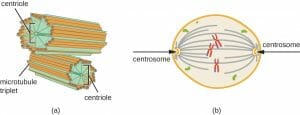Centrioles are microscopic cylinders (microtubules) that are the building blocks of centrosomes. A single centriole consists of 9 microtubule triplets arranged in the shape of a cylinder with 2 centrioles making up each centrosome. Centrioles are responsible for organizing the spindle fibers in the mitotic spindle apparatus and are thought to participate in the completion of cytokinesis during the process of cell division.
It is interesting to note that a cell can still divide if the centrosome is removed, although mitosis takes a lot longer and there are more errors in chromosome division. In addition, plant cells do not have centrioles or centrosomes but are still capable of cell division. This information has led scientists to think that centrioles evolved as an improvement in cell division which made the process faster and less error-prone.

The image above shows (a) how centrioles are a component of centrosomes and (b) how centrosomes are involved in cell division.
References
- Centriole. (n.d.). In Wikipedia. Retrieved September 13, 2017 from https://en.wikipedia.org/wiki/Centriole
